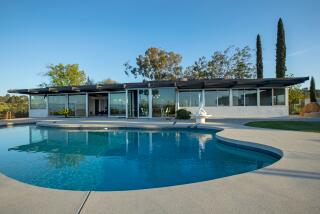55 Buildings, City Hall Get Sprinkler Mandate
- Share via
The San Diego City Council on Monday agreed to order the city’s 55 older high-rise buildings and City Hall retrofitted with fire sprinklers by 1999, a painstaking rehabilitation that will cost at least $145 million.
Triggered by a multimillion-dollar fire in Los Angeles’ unprotected First Interstate Bank Building that killed one person May 4, the sprinkler installation ordinance was endorsed by city Fire Marshal James Sewell and by the association of high-rise building owners and managers who will bear the brunt of its cost. Council will take a final vote on the order in two weeks.
Citing 540 fire deaths in U. S. high-rises during the last 20 years--490 of them in residential buildings--Sewell told the council that “this data clearly shows the need for the increased level of protection in these buildings provided only by fire sprinkler systems.”
Expensive Endeavor
But Sewell acknowledged that the sprinkler installation could be very costly to building owners who must remove or encapsulate any asbestos they find while placing the sprinklers in the 32 residential and 23 commercial buildings that now lack them.
Sewell “conservatively” estimated the cost of handling the asbestos at $16 to $22 a square foot, substantially more than the $1.35 to $1.85 a square foot it costs to install a sprinkler system itself. The citywide estimate of $141 million does not include the costs of temporarily relocating tenants if asbestos work cannot be conducted while they work or live in the building. Renovations at City Hall will cost the city an estimated $4 million, which is not now budgeted.
William Waite, a member of the Building Owners and Managers Assn.’s sprinkler committee, said the cost of installing the sprinklers and handling asbestos will more likely total $19 to $34 a square foot.
The city has required sprinklers and other fire-safety accommodations in the 71 high-rise buildings built or planned since 1976. But, when the First Interstate fire demonstrated the danger to office buildings, hotels and high-rise dwellings without sprinklers, District 2 Councilman Ron Roberts, an architect, initiated legislation to retrofit older structures.
The city delayed while a bill requiring sprinklers made its way through the Legislature, then again moved forward with its own ordinance when Gov. George Deukmejian vetoed the final, altered bill at its author’s request.
Retrofitting Plans
The city ordinance requires owners of buildings more than 75 feet tall to submit retrofitting plans to the fire chief by Jan. 1, 1990. In those buildings where asbestos removal is not required, owners would install sprinklers over the next nine years at the latest, meeting 1993 and 1996 deadlines for partial installation.
In a compromise measure, the council gave owners with asbestos-removal requirements the opportunity to install sprinklers throughout their buildings by 1996, without meeting the interim deadlines, if the fire chief concurs. The clause is aimed at those building owners who may have to temporarily empty their structures of tenants in order to safely dispose of asbestos.
Roberts opposed that provision when it was intended to apply to all 55 high-rises and attempted to have it deleted from the ordinance. He predicted that it would allow building owners to delay sprinkler installation until 1996, leaving the fire danger unresolved until then.
“At the end of that sixth or seventh year, you’re going to have to empty out all 55 buildings,” he said.
But City Manager John Lockwood argued that he might need to take advantage of that clause and move city workers out of the building while City Hall is retrofitted.
The council agreed to discuss the issue again when the required second reading of the ordinance is brought before it in two weeks. Owners of all 55 buildings will be notified before that meeting and given another chance to testify on its merits.
More to Read
Sign up for Essential California
The most important California stories and recommendations in your inbox every morning.
You may occasionally receive promotional content from the Los Angeles Times.













